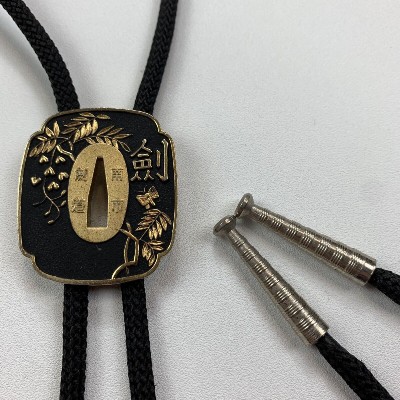Affiliate Disclaimer: We work to provide bolo ties and locate merchants who sell the products you are looking for. If you make a purchase from any of the merchants we endorse, we will earn a small commission at no additional cost to you. Thank you for your support!
Japanese Tsuba Sword Guards: A Fusion of Artistry and Functionality
Bolo Tie Japanese Tsuba Sword Guard
 In the realm of traditional Japanese sword craftsmanship, the tsuba stands as a small yet significant component that holds a rich and storied history. As a sword guard, the tsuba plays a crucial role in both protecting the wielder's hand and enhancing the overall aesthetics of the sword. Beyond its utilitarian purpose, tsuba also serves as a canvas for artists to express their creativity and cultural heritage.
In the realm of traditional Japanese sword craftsmanship, the tsuba stands as a small yet significant component that holds a rich and storied history. As a sword guard, the tsuba plays a crucial role in both protecting the wielder's hand and enhancing the overall aesthetics of the sword. Beyond its utilitarian purpose, tsuba also serves as a canvas for artists to express their creativity and cultural heritage.Origins and Evolution
The origins of tsuba can be traced back to ancient Japan, where warriors recognized the need for a protective guard to prevent their hands from slipping onto the blade during combat. Early tsuba were simple, unadorned, and often made of basic materials such as wood or iron. However, as the art of swordsmanship developed and samurai culture flourished, tsuba transformed into intricately crafted masterpieces.Artistic Expression
Japanese tsuba artisans embraced the opportunity to showcase their creativity through the intricate designs and motifs engraved or carved onto the guard's surface. Subjects ranged from nature-inspired patterns like cherry blossoms and waves to mythological creatures and historical scenes. Each tsuba tells a unique story, capturing the essence of the artist's imagination and cultural values.Materials and Techniques
Tsuba were crafted using various materials, including iron, copper, brass, gold, silver, and alloys. The crafting process involved meticulous techniques such as carving (horimono), inlaying (zogan), and openwork (sukashi), each demanding the utmost skill and precision. Some tsuba were also adorned with precious stones, adding a touch of opulence to these functional art pieces.Symbolism and Spiritual Beliefs
Beyond their ornamental appeal, tsuba often held deep symbolic significance. Samurai believed that the tsuba acted as a protective barrier, not only for their hands but also as a spiritual shield. Certain designs, such as family crests (mon), brought good fortune and symbolized loyalty to their clans.Collectors' Treasures
In modern times, tsuba continue to captivate art collectors and enthusiasts alike. Antique tsuba from renowned artisans of the past are highly sought after and command great value in the art market. Each piece reflects the craftsmanship, historical context, and cultural significance of the era in which it was created.Preserving Traditions
Despite the advancement of modern weaponry, the tradition of tsuba craftsmanship endures. Contemporary artisans, known as tsubako, continue to produce tsuba using traditional methods, keeping the ancient art alive and thriving. These skilled artists pay homage to their predecessors while infusing their unique creativity into each piece.In conclusion, Japanese tsuba sword guards transcend their utilitarian function and emerge as exquisite works of art that embody the essence of Japan's rich cultural heritage. As symbols of skill, tradition, and artistic expression, tsuba remind us of the enduring spirit of the samurai and the legacy they left behind in the world of traditional Japanese craftsmanship.

Bolo Tie Japanese Tsuba
References
The Metropolitan Museum of Art - Tsuba: The Japanese Sword GuardWikipedia - Tsuba
The Society for Preservation of Japanese Art Swords - Tsuba
Japanese Tsuba Gallery
Arts and Designs Japan - Kodogu (Tsuba and Sword Fittings)
JapanTsuba - Japanese Tsuba: Artistry in Iron
